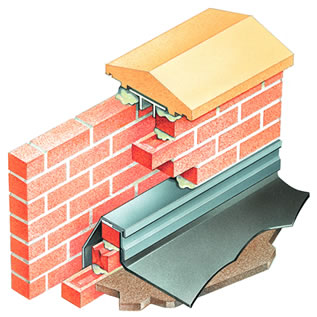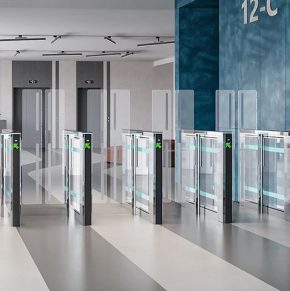
Parapet DPC stepping inwardly results in damp internal wall
The company recommends its Type P self supporting cavitray as a safe solution, designed to improve the structural stability of a cavity parapet whilst preventing any staining on the front elevation.
The cavitray is built into the inner skin and has a downward spanning section that crosses the cavity and exits against the inside face of the exterior skin, allowing it to remain unpunctuated as the preformed cavitray does not project through it.
The Type P projects through the inner skin downwardly to form a turn-down exterior lip, providing weathering cover to the bedding course of the cavitray and protection in areas where the roof flashing unites under the tray.
Building into both masonry skins to provide support to cavity spanning DPC’s was introduced as there were few alternative ways to hold a soft or pliable DPC in place, however Cavity Trays warns that the practice can cause structural issues when the DPC is exposed to high levels of wind pressure.
Parapet DPC’s at a high level that step inwardly allow for water to under track the supported DPC and trickle towards the inner skin of the cavity parapet below roof level, resulting in significant damage to the internal wall.
Latest news

17th April 2025
Nuaire shares expertise at Specifi Mechanical Services events in 2025
Indoor air quality and ventilation manufacturing specialist Nuaire is pleased to be exhibiting at the Specifi Mechanical Services events once again in 2025.
Posted in Air Conditioning, Articles, Building Industry Events, Building Industry News, Building Products & Structures, Building Services, Exhibitions and Conferences, Facility Management & Building Services, Heating, Ventilation and Air Conditioning - HVAC, Restoration & Refurbishment, Retrofit & Renovation
15th April 2025
West Fraser: CaberDek earns top marks from Home Counties carpentry specialist
A specialist carpentry sub-contractor covering housing sites across a large swathe of the Home Counties has come to value CaberDek from the West Fraser range for a variety of reasons: not least because the high quality panel product doesn’t destroy his operatives’ electric saws!
Posted in Articles, Building Industry News, Building Products & Structures, Building Systems, Case Studies, Restoration & Refurbishment, Retrofit & Renovation, Roofs, Timber Buildings and Timber Products, Wooden products
15th April 2025
GEZE: The Role of Access Control Systems in Enhancing Building Safety
Jane Elvins, Specification and Business Development Manager at GEZE UK, delves into the role of access control systems in enhancing building safety…
Posted in Access Control & Door Entry Systems, Architectural Ironmongery, Articles, Building Industry News, Building Products & Structures, Building Services, Doors, Facility Management & Building Services, Health & Safety, Restoration & Refurbishment, Retrofit & Renovation, Security and Fire Protection
11th April 2025
Don’t Do a Dave! It’s Time to Lock FIT Show 2025 in Your Calendar!
It’s that time again – FIT Show is back! You could be forgiven for thinking there won’t be much new to see when FIT Show returns to the NEC from 29 April – 1 May. Wrong!
Posted in Articles, Building Industry Events, Building Industry News, Building Products & Structures, Building Services, Continuing Professional Development (CPD's), Exhibitions and Conferences, Information Technology, Innovations & New Products, Restoration & Refurbishment, Retrofit & Renovation, Seminars, Training
 Sign up:
Sign up: